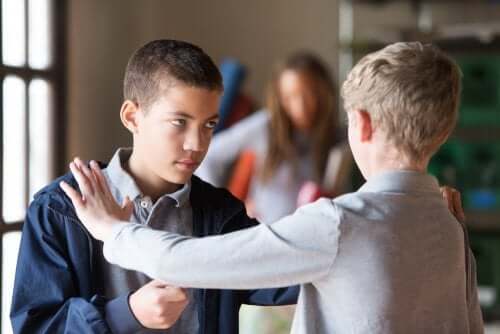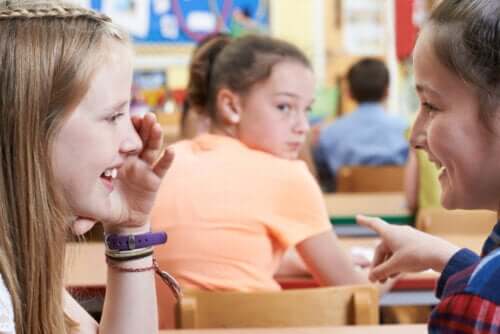Common Characteristics of School Bullies


Written and verified by the psychologist Marián Carrero Puerto
Nowadays, school bullying has become very common among children. The media reports more cases than we’d like to know of. In addition, social media platforms keep showing us different cases of violence among peers. But, why do children become violent? In this article, we’ll talk about some common characteristics of school bullies.
When certain children become violent towards their schools peers, we’re talking about school bullying. At school, it’s possible to recognize the bully and the person being bullied, depending on their personalities. However, today, we’ll focus on the characteristics of school bullies.
In the case of bullies, their aggressive behavior towards their peers might be a sign of psychoticism. And, in the case of the victims, their personalities might be signs of introversion or low self-esteem. These characteristics can be quite harmful for children and they may determine the kid’s future.
“The common mistake that bullies make is assuming that because someone is nice that he or she is weak. Those traits have nothing to do with each other. In fact, it takes considerable strength and character to be a good person.”
– Mary Elizabeth Williams –

Common characteristics of school bullies
Bullies share certain characteristics with each other. In fact, three out of four bullies are boys. Besides, they’re usually physically strong. Therefore, they tend to become violent towards those children who they consider to be weak and coward. Furthermore, they think they’re honest and assertive leaders. And, sometimes, they end up provoking others.
When talking about their personality, we can say that these kids present a high level of psychoticism, extroversion and honesty. Besides, they might be a bit neurotic. All these characteristics are the exact opposite of the characteristics that children who are bullied present.
In terms of evolution, it’s been proven that girls of the same age have higher social cognitive skills than boys. As a result, this would help girls react against bullying.
According to this hypothesis, this aggressive behavior seems to increase in time. It’s also known that during preschool, boys develop aggressive and disruptive behavior, while girls tend to develop prosocial skills.
Furthermore, bullies and their accomplices show deficits in the moral and emotional aspects of empathy. Plus, they find it easy to have perspective, and they’re impulsive. Usually, victims have lower social status than their bullies. However, popularity differs according to gender.
Male bullying is related to the desire of being accepted by other aggressive children. While in the case of girls, bullying relates to the desire of being accepted in general.
“What if the kid you bullied at school grew up, and turned out to be the only surgeon who could save your life?”
– Lynette Mather –

What can we do about this?
The different violent and abusive situations among classmates are very common within the school environment.
What’s more, adults usually get to know about this when the problem is firmly established, its repercussions are shocking, and the possibilities of changing the situations are scarce. When this occurs, parents and teachers must gather all possible information, in order to try to control the situation.
The best way to address this situation is by paying attention to the school and family context. Regarding school, teachers are the responsible adults, who should look after these kids, promoting reconciliation between bullies and their victims. To do this, they should develop strategies to help them, by explaining the reasons for such behaviors.
At home, parents are the ones in charge of explaining to their children how they’re supposed to act in front of their peers. To do this, parents must work on developing assertive communication.
It’s important for parents to observe their children’s inappropriate behaviors and help them develop strategies to change them. Sometimes, they may even have to punish their children, when there’s no other alternative. In fact, there are more extreme cases, in which parents will have to ask for professional help, in order to solve this problem.
“The bullying stopped when I claimed myself and proved that I wasn’t afraid.”
– Randy Harrison –
Nowadays, school bullying has become very common among children. The media reports more cases than we’d like to know of. In addition, social media platforms keep showing us different cases of violence among peers. But, why do children become violent? In this article, we’ll talk about some common characteristics of school bullies.
When certain children become violent towards their schools peers, we’re talking about school bullying. At school, it’s possible to recognize the bully and the person being bullied, depending on their personalities. However, today, we’ll focus on the characteristics of school bullies.
In the case of bullies, their aggressive behavior towards their peers might be a sign of psychoticism. And, in the case of the victims, their personalities might be signs of introversion or low self-esteem. These characteristics can be quite harmful for children and they may determine the kid’s future.
“The common mistake that bullies make is assuming that because someone is nice that he or she is weak. Those traits have nothing to do with each other. In fact, it takes considerable strength and character to be a good person.”
– Mary Elizabeth Williams –

Common characteristics of school bullies
Bullies share certain characteristics with each other. In fact, three out of four bullies are boys. Besides, they’re usually physically strong. Therefore, they tend to become violent towards those children who they consider to be weak and coward. Furthermore, they think they’re honest and assertive leaders. And, sometimes, they end up provoking others.
When talking about their personality, we can say that these kids present a high level of psychoticism, extroversion and honesty. Besides, they might be a bit neurotic. All these characteristics are the exact opposite of the characteristics that children who are bullied present.
In terms of evolution, it’s been proven that girls of the same age have higher social cognitive skills than boys. As a result, this would help girls react against bullying.
According to this hypothesis, this aggressive behavior seems to increase in time. It’s also known that during preschool, boys develop aggressive and disruptive behavior, while girls tend to develop prosocial skills.
Furthermore, bullies and their accomplices show deficits in the moral and emotional aspects of empathy. Plus, they find it easy to have perspective, and they’re impulsive. Usually, victims have lower social status than their bullies. However, popularity differs according to gender.
Male bullying is related to the desire of being accepted by other aggressive children. While in the case of girls, bullying relates to the desire of being accepted in general.
“What if the kid you bullied at school grew up, and turned out to be the only surgeon who could save your life?”
– Lynette Mather –

What can we do about this?
The different violent and abusive situations among classmates are very common within the school environment.
What’s more, adults usually get to know about this when the problem is firmly established, its repercussions are shocking, and the possibilities of changing the situations are scarce. When this occurs, parents and teachers must gather all possible information, in order to try to control the situation.
The best way to address this situation is by paying attention to the school and family context. Regarding school, teachers are the responsible adults, who should look after these kids, promoting reconciliation between bullies and their victims. To do this, they should develop strategies to help them, by explaining the reasons for such behaviors.
At home, parents are the ones in charge of explaining to their children how they’re supposed to act in front of their peers. To do this, parents must work on developing assertive communication.
It’s important for parents to observe their children’s inappropriate behaviors and help them develop strategies to change them. Sometimes, they may even have to punish their children, when there’s no other alternative. In fact, there are more extreme cases, in which parents will have to ask for professional help, in order to solve this problem.
“The bullying stopped when I claimed myself and proved that I wasn’t afraid.”
– Randy Harrison –
All cited sources were thoroughly reviewed by our team to ensure their quality, reliability, currency, and validity. The bibliography of this article was considered reliable and of academic or scientific accuracy.
- Chimal, A. M., López, J. C. G., Margarita, G., Peña, G., de la Luz Esteban, J. M., Valdés, P. B. N., … & Valencia, V. N. S. Autoestima y acoso escolar en los niños de primaria y secundaria.
- La violencia en las aulas : análisis y propuestas de intervención. Fuensanta Cerezo Ramírez Madrid : Pirámide , 2004.
- Zegarra, S. P., Barrón, R. G., Marqués, C. M., Berlanga, J. F., & Pallás, C. M. (2009). Diferencias conductuales según género en convivencia escolar. Psicothema, 21(3), 453-458.
This text is provided for informational purposes only and does not replace consultation with a professional. If in doubt, consult your specialist.








